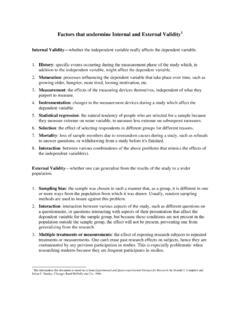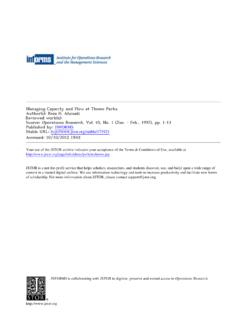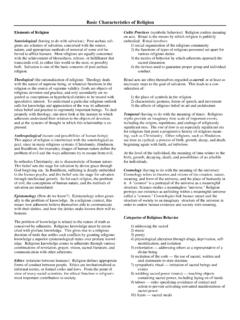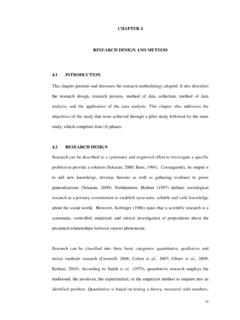Transcription of Types of Scales Introduction: There are 4 types of scales ...
1 Types of ScalesIntroduction: There are 4 Types of Scales , based onthe extent to which scale values have the arithmeticproperties of true numbers. The arithmetic proper-ties are order, equal intervals, and a true zero the least to the most mathematical, the scaletypes are nominal, ordinal, interval, and Scales have no arithmetic properties. Ratioscales have all three of the arithmetic properties. Or-dinal and interval Scales fall in between nominal andratio Nominal Scales do not measure quantity, onlytype. Nominal Scales classify members of a popula-tion into 2 or more categories. The categories must bemutually exclusive and exhaustive, , each andevery member of the population must be capable ofbeing classified into one, and only one Scales have no arithmetic properties.
2 Nocategory is greater or lesser than any other category values are simply names (hence theterm nominal). The only mathematical statementsthat can be made about nominal data consist of rela-tive comparisons between the number of populationmembers in each category, called proportions. Someexamples of nominal Scales are respondent's sex, re-spondent's religious affiliation, respondent's politicalparty affiliation, respondent's ethnicity, or respon-dent's college Ordinal Scales "order" members of a populationinto ranks, from most to least, or least to most. Rankvalues do not possess the arithmetic property ofequal intervals or true zero points. This means that,with ordinal data, we know only that one member ofa population has either more or less of some qualitythan another member, but we do not know just howmuch more or less.
3 For example, we can not say howmuch better the best tennis player is than the 2ndbest player, or the 3rd best player is than the 4thbest player. In order to know just how much betterone rank is than another would require equal intervalsbetween ranks in order to perform addition and sub-traction. Also, we can not say that the 2nd best ten-nis player is twice as good as the 4th best tennisplayer. This would require a true zero rank in orderto perform multiplication and division. Some exam-ples of ordinal Scales are ranking of beauty contestwinners, sports rankings of players and teams, orranking of respondent's preferences for different fla-vors of ice Interval Scales have the property of order, andalso the property of equal intervals.
4 Each interval onan interval scale is equal to every other interval onthe scale. Hence, addition and subtraction are validarithmetic operations for interval data. However,interval Scales do not have a true zero point. There -fore, multiplication and division are not valid usinginterval data. Some interval Scales , such as the centi-grade temperature scale, have zero points, but theyare arbitrary zero points. Arbitrary zero points donot mean the absence of the quality. For example, 0 centigrade does not mean an absence of heat. Becauseof the arbitrary meaning of 0 centigrade, 8 is nottwice as warm as 4 . Absolute zero centigrade is -276 . There are few interval Scales used in the socialsciences. In the 1950's, social psychologists devised amethod of constructing interval Scales for measuringattitudes.
5 The method is cumbersome, and not with-out questionable assumptions. Some examples ofcommonly used interval Scales in our daily lives arethe centigrade and Fahrenheit temperature Scales ,clothing sizes, and the common clock and Ratio Scales get their name from the fact that ra-tios can be calculated using ratio data. However, donot confuse the meaning of ratio with ratio are not identical terms. Ratio Scales have all thearithmetic properties of interval Scales , plus a truezero point. Therefore, ratio data can be treated astrue numbers, permitting addition and subtraction,and multiplication and division. Ratio Scales are usedfrequently in the social sciences, and in every-daylife. Some examples of ratio Scales are respondent'syearly income, respondent's age, height, or weight,and the number of individuals living in respondent'shousehold.










